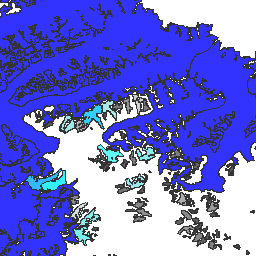
- Dostępność zbioru danych
- 1750-01-01T00:00:00Z–2023-06-07T00:00:00Z
- Dostawca zbioru danych
- National Snow and Ice Data Center (NSDIC)
- Tagi
Opis
Global Land Ice Measurements from Space (GLIMS) to międzynarodowa inicjatywa,której celem jest wielokrotne badanie około 200 tys. lodowców na całym świecie.
Celem projektu jest stworzenie globalnego spisu lodu lądowego, w tym pomiarów powierzchni lodowców, ich geometrii, prędkości powierzchniowej i wysokości linii śniegu. Do przeprowadzenia tych analiz projekt GLIMS wykorzystuje dane satelitarne, głównie z radiometru ASTER (Advanced Spaceborne Thermal Emission and Reflection Radiometer) i skanera ETM+ (Landsat Enhanced Thematic Mapper Plus), a także informacje historyczne pochodzące z map i zdjęć lotniczych.
Każda cecha w tym zbiorze danych to wielokątna granica lodowca w momencie analizy. Kilka identyfikatorów lodowców ma setki różnych wierszy w czasie.
Ten zbiór danych to migawka zasobów granic lodowców z 7 czerwca 2023 r. Zawiera ponad 1,1 mln wierszy.
Schemat tabeli
Schemat tabeli
| Nazwa | Typ | Opis |
|---|---|---|
| analitycy, | CIĄG ZNAKÓW | Imiona i nazwiska współtwórców danych |
| anlys_id | LICZBA ZMIENNOPRZECINKOWA O PODWÓJNEJ PRECYZJI | Identyfikator lodowca w określonym czasie |
| anlys_time | CIĄG ZNAKÓW | Kiedy przeprowadzono analizę |
| obszar | LICZBA ZMIENNOPRZECINKOWA O PODWÓJNEJ PRECYZJI | Powierzchnia lodowca na płaszczyźnie projekcji mapy w kilometrach kwadratowych |
| chief_affl | CIĄG ZNAKÓW | Przynależność szefa centrum regionalnego |
| db_area | LICZBA ZMIENNOPRZECINKOWA O PODWÓJNEJ PRECYZJI | Podobnie jak „area”, ale ponownie obliczone przez projekt GLIMS. |
| geog_area | CIĄG ZNAKÓW | Nazwa regionu geograficznego objętego regionalnym centrum danych |
| glac_id | CIĄG ZNAKÓW | Identyfikator lodowca GLIMS |
| glac_name | CIĄG ZNAKÓW | Nazwa lodowca. Około 80% wierszy ma wartość „Brak” |
| glac_stat | CIĄG ZNAKÓW | Stan Glacier, czyli „exists” lub „None” |
| długość | LICZBA ZMIENNOPRZECINKOWA O PODWÓJNEJ PRECYZJI | Długość obwodu lodowca w metrach |
| line_type | CIĄG ZNAKÓW | Typ rekordu lodowca, np. „glac_bound” w przypadku lodowców lub inne wartości w przypadku skał wewnętrznych, linii śniegu, zbiorników wodnych itp. |
| local_id | CIĄG ZNAKÓW | Identyfikator przypisany przez instytucję lub centrum regionalne |
| max_elev | LICZBA ZMIENNOPRZECINKOWA O PODWÓJNEJ PRECYZJI | Najwyższa część lodowca, w metrach nad poziomem morza |
| mean_elev | LICZBA ZMIENNOPRZECINKOWA O PODWÓJNEJ PRECYZJI | Średnia wysokość lodowca nad poziomem morza w metrach |
| min_elev | LICZBA ZMIENNOPRZECINKOWA O PODWÓJNEJ PRECYZJI | Najniższa część lodowca w metrach nad poziomem morza |
| parent_id | CIĄG ZNAKÓW | Identyfikator lodowca, który jest lodowcem nadrzędnym tego lodowca |
| primeclass | LICZBA ZMIENNOPRZECINKOWA O PODWÓJNEJ PRECYZJI | Numer klasyfikacji lodowca WGMS |
| proc_desc | CIĄG ZNAKÓW | Opis przetwarzania wykonanego w tym rekordzie |
| rc_id | LICZBA ZMIENNOPRZECINKOWA O PODWÓJNEJ PRECYZJI | Identyfikator używany przez centrum regionalne |
| rec_status | CIĄG ZNAKÓW | Stan rekordu |
| release_dt | CIĄG ZNAKÓW | Data udostępnienia danych w formacie RRRR-MM-ddTHH:mm:ss. |
| src_date | CIĄG ZNAKÓW | Data obrazów źródłowych użytych do utworzenia konturu |
| subm_id | LICZBA ZMIENNOPRZECINKOWA O PODWÓJNEJ PRECYZJI | Identyfikator przesłania przypisany przez GLIMS |
| osób przesyłających, | CIĄG ZNAKÓW | Imię i nazwisko osoby przesyłającej dane |
| wgms_id | CIĄG ZNAKÓW | Identyfikator Światowej Służby Monitorowania Lodowców |
| szerokość | LICZBA ZMIENNOPRZECINKOWA O PODWÓJNEJ PRECYZJI | Szerokość lodowca w metrach |
Warunki korzystania z usługi
Warunki korzystania z usługi
W przypadku tworzenia raportów, publikacji, nowych zbiorów danych, produktów pochodnych lub usług wynikających z zbioru danych użytkownicy powinni podać źródło: GLIMS and NSIDC (2005, updated 2013): Global Land Ice Measurements from Space glacier database. Opracowane i udostępnione przez międzynarodową społeczność GLIMS oraz National Snow and Ice Data Center, Boulder, CO, USA, doi:10.7265/N5V98602
DOI
Odkrywanie za pomocą Earth Engine
Edytor kodu (JavaScript)
var dataset = ee.FeatureCollection('GLIMS/current'); var visParams = { palette: ['gray', 'cyan', 'blue'], min: 0.0, max: 10.0, opacity: 0.8, }; var image = ee.Image().float().paint(dataset, 'area'); Map.setCenter(-35.618, 66.743, 7); Map.addLayer(image, visParams, 'GLIMS/current'); Map.addLayer(dataset, null, 'for Inspector', false);
Wyświetlanie jako widok cech
FeatureView to przyspieszona reprezentacja FeatureCollection, którą można tylko wyświetlać. Więcej informacji znajdziesz w
FeatureView dokumentacji.
Edytor kodu (JavaScript)
var fvLayer = ui.Map.FeatureViewLayer('GLIMS/current_FeatureView'); var visParams = { color: { property: 'area', mode: 'linear', palette: ['gray', 'cyan', 'blue'], min: 0.0, max: 10.0 }, opacity: 0.8, polygonStrokeOpacity: 0 }; fvLayer.setVisParams(visParams); fvLayer.setName('GLIMS/current'); Map.setCenter(-35.618, 66.743, 7); Map.add(fvLayer);
